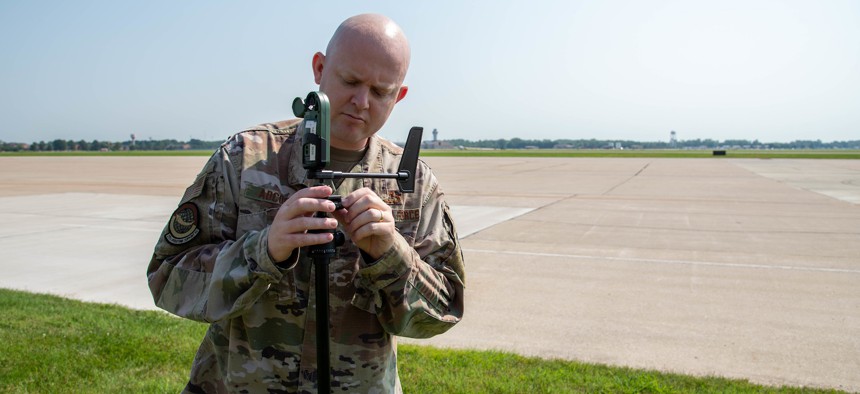
Senior Master Sgt. Michael Adcock sets up a Kestrel on the flightline at Scott Air Force Base, Ill., Aug. 25, 2020. U.S. Air Force / Airman 1st Class Shannon Moorehead
Air Force’s Mideast drone experiments may feed Replicator effort
Among them could be a 3D-printed, $2,500 drone called the Kestrel.
Almost one year into Air Force Central Command’s push to field unmanned technologies, the unit says it's already using some of its new drones in Middle East operations, and is funneling these ideas all the way back to the Pentagon.
The Air Force’s Task Force 99 “nests very well” within the Pentagon’s new Replicator drone program, AFCENT commander Lt. Gen. Alex Grynkewich said Wednesday. Launched in August by Deputy Defense Secretary Kathleen Hicks, Replicator aims to build cheap drones in the “multiple thousands” within the next two years.
The Mideast-based task force is hoping Replicator will lift some of its concepts off the ground, Grynkewich told reporters at a Defense Writers Group event.
With only about 15 people, the unit “doesn't have the ability right now to scale, to operate thousands of these capabilities. I think what Replicator will do is help us make that shift,” he said.
The unit has almost 100 unmanned systems “either on order or on hand” across 13 types that can travel anywhere from 10 miles to 900 miles and conduct intelligence-surveillance-reconnaissance or attack missions. Grynkewich highlighted the group’s new Kestrel, a 3D-printed drone.
“We can make this thing for about $2,500,” he said. “It can go roughly 100 kilometers, so not a huge range, but something that can be relevant on the battlefield.”
Five nations are working with U.S. forces on Task Force 99, and there are “several others that I think will come on board in the next several months,” the general said.
Grynkewich said the unit’s main objectives include increasing air domain awareness, conducting ISR missions, and “imposing dilemmas on the adversary,” which could include one-way kinetic attacks or spectrum warfare.
The general stressed that the group isn’t just a hub for innovation, but an operational force that is already using these drones in real missions.
“We've used them for intelligence, surveillance, and reconnaissance missions. I won't get into the when and where due to the classification issues, but I will say that we have used them for ISR and they've proven capable,” he said.
Grynkewich said some of these drones have already proved more useful than the Air Force’s MQ-9 drone, which has great “capability” but is limited. Using smaller drones with high-resolution cameras that fly lower than the MQ-9 has allowed AFCENT to gather data on potential threats, he said.
“That's one use case that we've really started to flush out and one that we are proposing again to DepSecDef Hicks for this Replicator,” he said.
Grynkewich is also working closely with Army Central Command on counter-drone systems, noting an app called Carpe Dronvm, “seize the drone,” which the services have been developing with MITRE to find and track drones.
“Someone who's wandering around who had this app on their phone could take a picture of the drone and then an alert would go up to people in the area that the drone was there. There's some AI on the back end that can help identify what the drone is. They can build track files if enough people take pictures of it,” Grynkewich said.
The Army is incorporating Carpe Dronvm into the Red Sands Integrated Experimentation Center, he said, which is run in conjunction with Saudi Arabia to test out new technologies.





